CES 2014: The $8,000 'snore-stopping' superbed
- Published
Sleep Number's hi-tech bed
In our hyper-connected world, in which dinners are interrupted by smartphones, and where 75% of us (one study says) check our messages while on the loo, you can see why it's hard for manufacturers to find a gap in the market.
That's why many companies are steering their attention away from our waking hours and instead focusing on the mostly untouched world of sleep.
Several apps and fitness trackers already keep tabs on how we move around in bed, but one noticeable trend at this year's CES in Las Vegas was just how many innovations promised to help you get a good night's kip - or at least find out why you're feeling tired.
One such company, Sleep Number, takes it very seriously.
Its $8,000 (£4,800) "superbed" - launched at the show - is loaded with monitoring technology, all of which reports back to a tablet app that can be reviewed in daylight hours.
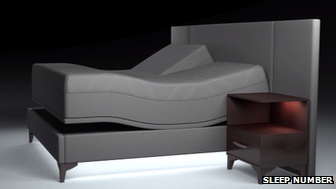
Sleep Number's x12 bed can shape its two mattresses to help each sleeper get a better night's rest
Firstly, it monitors the entire body's movements - an advantage over basic fitness trackers that are limited to movements of the wrist, or to wherever the device is attached.
Secondly, it can work out who's who on the bed, so if one person has had a sleepless night, the app will work out if it was the fault of the fidgety person next to them.
If necessary, it can alter the firmness of the bed on just one side, helping one person be more comfortable without disturbing the other.
And another feature, likely to delight long-suffering partners the world over, is the bed's claimed ability to help stop snoring.
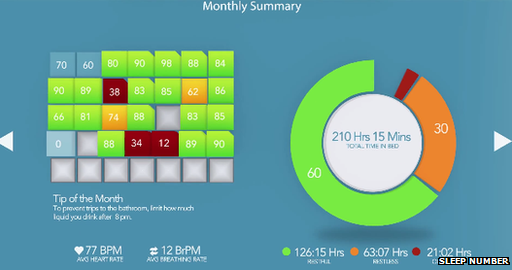
The sleep-obsessed can get digital feedback and tips from the bed's own app
By gently moving the snorer up and down the bed opens their airways without interrupting their slumber.
It's a 2014 upgrade, you could say, to a friendly shove or holding of the nose.
"Too much lately we don't get enough sleep," says Pete Bils from Sleep Number.
"That places a premium on the quality of sleep that we get."
Relaxing lamps
That's a point of view shared by many here who think the way to feel better rested in the modern age is not to just get to bed earlier, as your mother would tell you, but to sleep smarter, making the most of the time you have between the sheets.
Alain Amador shows off Withings' Aura lamp system to the BBC's Dave Lee
For instance, one conference attendee - who didn't want to be named for fear of being told off - said his girlfriend regularly had trouble sleeping.
The problem, they later found thanks to a sleep tracking device, was that she was going to bed too early and becoming unnecessarily restless during the night.
The point is, argue the backers of this technology, we historically haven't paid much attention to how we sleep, beyond what time we get in, and what time we get up.
"You spend about a third of your life in bed," says Alain Amador, from Withings. The French company is showing off its own sleep monitor technology, the Aura, this week.
"As of now we've only done tracking, but nothing to help you go to sleep and wake up."
Withings' product centres on a special, and very colourful, lamp.
If you want to go to sleep, it plays some relaxing noises and emits a soft, red light into the room.
The colour is, Withings says, scientifically proven to stimulate the release of melatonin, a hormone which brings on a feeling of sleepiness.
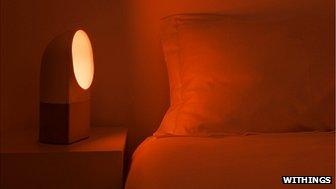
Withings says shining a red light over the bedroom should help you get to sleep
In the morning, a blue light has the opposite effect - suppressing melatonin and encouraging us to wake up and be more alert.
A sensor pad placed under the mattress means the Aura is also taking note of when you're moving around the most, so that it can wake you up when you're not in deep sleep.
That means, in theory, you get out of bed in less of a jarred, grumpy mood.
Invading dreams
There's about a dozen technologies at CES that deal specifically with issues around sleep, giving the whole affair the whiff of a bandwagon or fad.
SleepPhones offers a music-playing headband, described as "pyjamas for your ears", while Lighting Science's Good Night light bulb apparently filters out the light waves that "get in melatonin's way".
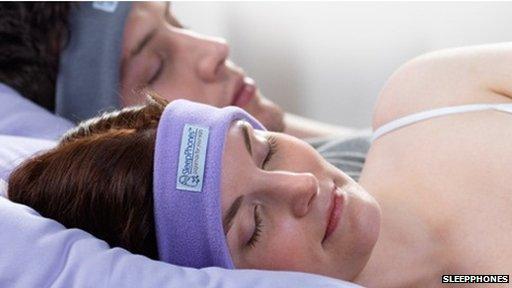
SleepPhones says its headband can be used to play meditation music to aid sleep
But Gartner analyst Brian Blau says the products should perhaps be given more credit for solving a long-neglected problem suffered by many.
"In the medical field, to diagnose your sleep problems you need to go to a special facility and be there for multiple nights," he says.
"So, maybe these consumer sleep products can help people with issues they have."
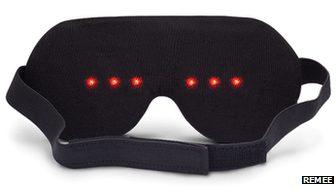
Remee's sleep mask contains six LEDs which light up in different patterns to create a "dream signal"
What next? If technology means we're out-for-the-count quicker and better than ever before, what else can gadgetry bring?
Remee - not on show at CES - leads the pack with its sleep mask that it says increases the frequency of lucid dreams - dreams where you're aware you are dreaming.
Six tiny LEDs shine into the wearer's eyes, not enough to wake them up, but to increase alertness ever so slightly, enough to trigger lucidity.
It could pave the way for controlling our dreams, and the things we see in them.
Whatever the technology, though, it can't stop one grim inevitability: you have to drag yourself out of bed eventually.
Follow Dave Lee on Twitter @DaveLeeBBC, external.
- Published6 January 2014